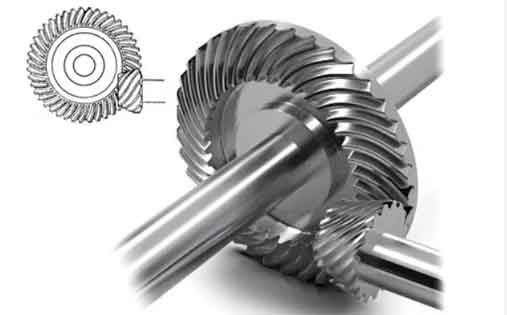Analyzing the efficiency of spiral bevel gears in high-speed applications requires a detailed understanding of their design characteristics, material properties, and the dynamics of spiral bevel gear operation under high-speed conditions. Spiral bevel gears are renowned for their ability to transmit power efficiently between intersecting shafts at various angles, most commonly at 90 degrees. Their unique design offers several advantages that are particularly beneficial in high-speed applications, such as in automotive, aerospace, and industrial machinery. The efficiency of spiral bevel gears in such scenarios is influenced by factors like tooth geometry, lubrication, thermal characteristics, and manufacturing precision.

Tooth Geometry and Contact
The spiral design of spiral bevel gear teeth allows for gradual engagement between the mating gears, which is crucial for high-speed operation. This gradual engagement reduces the impact forces that occur when teeth come into contact, thereby minimizing noise and vibration—a significant advantage over straight bevel gears. The extended contact along the length of the tooth ensures a more uniform distribution of load, enhancing spiral bevel geas ability to handle high stress and reducing wear over time.
Material and Heat Treatment
The materials used for spiral bevel gears, typically high-strength alloys, are selected for their durability and resistance to wear. Advanced heat treatment processes, such as case hardening, further improve the surface hardness and fatigue resistance of spiral bevel gears. These material properties are essential for maintaining the integrity and efficiency of spiral bevel gear system under the high rotational speeds and temperatures that are often encountered in high-speed applications.
Lubrication
Effective lubrication is vital for maintaining the efficiency of spiral bevel gears, especially at high speeds. Proper lubrication reduces friction between the mating surfaces, minimizing heat generation and wear. The choice of lubricant and the design of the lubrication system play critical roles in ensuring that spiral bevel gears operate within optimal temperature ranges, maintaining their efficiency and longevity.
Thermal Characteristics
At high speeds, the heat generated due to friction and the inefficiencies in spiral bevel gears transmission can lead to thermal expansion and distortion of gear components. Managing these thermal effects is crucial for maintaining the precision alignment of spiral bevel gears teeth and preventing loss of efficiency. Advanced cooling systems and materials with high thermal conductivity can help dissipate heat more effectively, ensuring that spiral bevel gears operate within their designed temperature ranges.
Manufacturing Precision
The efficiency of spiral bevel gears in high-speed applications is significantly influenced by the precision of their manufacturing. Any deviations from the ideal gear geometry can lead to improper tooth engagement, increased wear, and inefficiencies. High-precision manufacturing techniques, such as CNC machining and gear grinding, are employed to achieve the tight tolerances required for optimal gear performance.
Efficiency Considerations
Spiral bevel gears are generally very efficient, with typical efficiency ratings ranging from 95% to 99% under optimal conditions. However, the actual efficiency in high-speed applications can be influenced by the factors mentioned above. The design and engineering of spiral bevel gear system must carefully consider these elements to minimize losses and ensure the reliable transmission of power at high speeds.
Conclusion
In high-speed applications, spiral bevel gears exhibit a combination of efficiency, durability, and noise reduction that is difficult to match with other types of gears. The key to maximizing their efficiency lies in optimizing tooth geometry, material selection, lubrication, thermal management, and manufacturing precision. When these factors are carefully addressed, spiral bevel gears can provide a highly efficient and reliable solution for power transmission in demanding high-speed environments.
